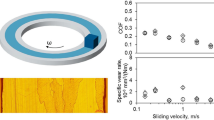Abstract
Due to its outstanding mechanical performance both in static and dynamic loading and its resistance up to very high temperatures, Polyetheretherketone (PEEK) has attracted many practical applications. The loaded contact state for the application of PEEK rolls as bearing elements was recently analyzed by the corresponding author. High irreversible deformations on the mantle side were caused by the rolling contact and thus the rolling performance is supposed to be strongly affected by the dynamic mechanical properties of this irreversibly deformed material. Tensile fatigue tests at various stress levels up to the thermally dominated fatigue regime were conducted in order to get information regarding the dynamic mechanical material behavior at high stress regimes. Two types of PEEK (annealed and untreated) were investigated and two load ratios, R, were used (0.1 and 0.5). During the fatigue tests extensometer strain, load and surface temperature were recorded and a quantitative hysteresis loop analysis with calculated secant modulus and dynamic modulus was performed. Furthermore, the concept of isocyclic stress–strain diagrams was applied to enlarge and confirm the results obtained from the hysteresis loop analysis. A sharp transition between thermally dominated and mechanically dominated fatigue regimes was found for both PEEK types (annealed and untreated) and for both load ratios. Moreover, the annealed PEEK was stiffer in the tensile fatigue tests than the untreated material. Both examined PEEK types showed distinct hardening throughout the fatigue tests which made them “more elastic” (higher stiffness and less damping).

















Similar content being viewed by others
References
Berer, M., Major, Z.: Characterization of the global deformation behaviour of engineering plastics rolls. Int. J. Mech. Mater. Des. 6, 1–9 (2010)
Berer, M., Major, Z.: Characterisation of the local deformation behaviour of engineering plastics rolls. Strain 48, 225–234 (2012)
Berer, M., Major, Z., Pinter, G.: Elevated pitting wear of injection molded polyetheretherketone (PEEK) rolls. Wear 297, 1052–1063 (2013)
Blundell, D., Osborn, B.: The morphology of poly(aryl-ether-ether-ketone). Polymer 24, 953–958 (1983)
Cebe, P.: Annealing study of poly(etheretherketone). J. Mater. Sci. 23, 3721–3731 (1988)
Cebe, P., Chung, S.Y., Hong, S.-D.: Effect of thermal history on mechanical properties of polyetheretherketone below the glass transition temperature. J. Appl. Polym. Sci. 33, 487–503 (1987)
Domininghaus, H., Elsner, P., Eyerer, P., Hirth, T.: Kunststoffe: Eigenschaften und Anwendungen, 7th edn. Springer, Berlin (2008) (in German)
Ferry, J.D.: Viscoelastic Properties of Polymers, 3rd edn. Wiley, New York (1980)
Hertzberg, R.W., Manson, J.A.: Fatigue of Engineering Plastics. Academic Press, New York (1980)
Heym, B., Beitz, W.: Zur Belastbarkeit von Stirnzahnrädern aus dem Hochtemperatur-Thermoplast PEEK. Konstruktion 47, 351–357 (1995) (in German)
Jones, D.P., Leach, D.C., Moore, D.R.: Mechanical properties of poly(ether-ether-ketone) for engineering applications. Polymer 26, 1385–1393 (1985)
Karger-Kocsis, J., Friedrich, K.: Temperature and strain-rate effects on the fracture toughness of poly(ether ether ketone) and its short glass-fibre reinforced composite. Polymer 27, 1753–1760 (1986)
Karger-Kocsis, J., Walter, R., Friedrich, K.: Annealing effects on the fatigue crack propagation of injection moulded PEEK and its short-fibre composites. J. Polym. Eng. 8, 221–255 (1988)
Lee, L.H., Vanselow, J.J., Schneider, N.S.: Effects of mechanical drawing on the structure and properties of peek. Polym. Eng. Sci. 28, 181–187 (1988)
Lesser, A.J.: Changes in mechanical behavior during fatigue of semicrystalline thermoplastics. J. Appl. Polym. Sci. 58, 869–879 (1995)
Lesser, A.J.: Effective volume changes during fatigue and fracture of polyacetal. Polym. Eng. Sci. 36, 2366–2374 (1996)
Lovinger, A.J., Davis, D.D.: Electron-microscopic investigation of the morphology of a melt-crystallized polyaryletherketone. J. Appl. Phys. 58, 2843 (1985)
Nisitani, H., Noguchi, H., Kim, Y.-H.: Evaluation of fatigue strength of plain and notched specimens of short carbon-fiber reinforced polyetheretherketone in comparison with polyetheretherketone. Eng. Fract. Mech. 43, 685–705 (1992)
Ostberg, G.M.K., Seferis, J.C.: Annealing effects on the crystallinity of polyetheretherketone (PEEK) and its carbon fiber composite. J. Appl. Polym. Sci. 33, 29–39 (1987)
Pinter, G., Ladstätter, E., Billinger, W., Lang, R.W.: Characterisation of the tensile fatigue behaviour of RTM-laminates by isocyclic stress–strain diagrams. Int. J. Fatigue 28, 1277–1283 (2006)
Rae, P., Brown, E., Orler, E.: The mechanical properties of poly(ether-ether-ketone) (PEEK) with emphasis on the large compressive strain response. Polymer 48, 598–615 (2007)
Ramkumar, A., Gnanamoorthy, R.: Axial fatigue behaviour of polyamide-6 and polyamide-6 nanocomposites at room temperature. Compos. Sci. Technol. 68, 3401–3405 (2008)
Rösler, J.: Zur Tragfähigkeitssteigerung thermoplastischer Zahnräder mit Füllstoffen. Dissertation, Fakultät V. Technische Universität, Berlin, Germany (2005) (in German)
Saib, K., Evans, W., Isaac, D.: The role of microstructure during fatigue crack growth in poly(aryl ether ether ketone) (PEEK). Polymer 34, 3198–3203 (1993)
Sobieraj, M.C., Murphy, J.E., Brinkman, J.G., Kurtz, S.M., Rimnac, C.M.: Notched fatigue behavior of PEEK. Biomaterials 31, 9156–9162 (2010)
Zahnt, B.-A.: Ermüdungsverhalten von Diskontinuierlich Glasfaserverstärkten Kunststoffen—Charakterisierungsmethoden, Werkstoffgesetze und Struktur-Eigenschafts-Beziehungen. Dissertation, Materials Science and Testing of Polymers, Montanuniversität Leoben, Austria (2003) (in German)
Acknowledgements
The research work of this paper was performed at the Polymer Competence Center Leoben GmbH (PCCL, Austria) within the framework of the COMET-programme of the Austrian Ministry of Traffic, Innovation and Technology with contributions by the Montanuniversitaet Leoben (Chair of Materials Science and Testing of Plastics). The PCCL is funded by the Austrian Government and the State Governments of Styria and Upper Austria.
Author information
Authors and Affiliations
Corresponding author
Rights and permissions
About this article
Cite this article
Berer, M., Major, Z., Pinter, G. et al. Investigation of the dynamic mechanical behavior of polyetheretherketone (PEEK) in the high stress tensile regime. Mech Time-Depend Mater 18, 663–684 (2014). https://doi.org/10.1007/s11043-013-9211-7
Received:
Accepted:
Published:
Issue Date:
DOI: https://doi.org/10.1007/s11043-013-9211-7




